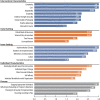Integrated interventions and supporting activities to increase uptake of multiple cancer screenings: conceptual framework, determinants of implementation success, measurement challenges, and research priorities
- PMID: 36199098
- PMCID: PMC9532830
- DOI: 10.1186/s43058-022-00353-8
Integrated interventions and supporting activities to increase uptake of multiple cancer screenings: conceptual framework, determinants of implementation success, measurement challenges, and research priorities
Abstract
Background: Screening for colorectal, breast, and cervical cancer has been shown to reduce mortality; however, not all men and women are screened in the USA. Further, there are disparities in screening uptake by people from racial and ethnic minority groups, people with low income, people who lack health insurance, and those who lack access to care. The Centers for Disease Control and Prevention funds two programs-the Colorectal Cancer Control Program and the National Breast and Cervical Cancer Early Detection Program-to help increase cancer screenings among groups that have been economically and socially marginalized. The goal of this manuscript is to describe how programs and their partners integrate evidence-based interventions (e.g., patient reminders) and supporting activities (e.g., practice facilitation to optimize electronic medical records) across colorectal, breast, and cervical cancer screenings, and we suggest research areas based on implementation science.
Methods: We conducted an exploratory assessment using qualitative and quantitative data to describe implementation of integrated interventions and supporting activities for cancer screening. We conducted 10 site visits and follow-up telephone interviews with health systems and their partners to inform the integration processes. We developed a conceptual model to describe the integration processes and reviewed screening recommendations of the United States Preventive Services Task Force to illustrate challenges in integration. To identify factors important in program implementation, we asked program implementers to rank domains and constructs of the Consolidated Framework for Implementation Research.
Results: Health systems integrated interventions for all screenings across single and multiple levels. Although potentially efficient, there were challenges due to differing eligibility of screenings by age, gender, frequency, and location of services. Program implementers ranked complexity, cost, implementation climate, and engagement of appropriate staff in implementation among the most important factors to success.
Conclusion: Integrating interventions and supporting activities to increase uptake of cancer screenings could be an effective and efficient approach, but we currently do not have the evidence to recommend widescale adoption. Detailed multilevel measures related to process, screening, and implementation outcomes, and cost are required to evaluate integrated programs. Systematic studies can help to ascertain the benefits of integrating interventions and supporting activities for multiple cancer screenings, and we suggest research areas that might address current gaps in the literature.
Keywords: Cancer screening; Evidence-based interventions; Integrated interventions; Multicomponent interventions.
© 2022. The Author(s).
Conflict of interest statement
The authors declare that they have no competing interests.
Figures
Similar articles
-
Integrated approaches to delivering cancer screenings to address disparities: lessons learned from the evaluation of CDC's Colorectal Cancer Control Program.Implement Sci Commun. 2022 Oct 11;3(1):110. doi: 10.1186/s43058-022-00346-7. Implement Sci Commun. 2022. PMID: 36221117 Free PMC article.
-
Factors that support readiness to implement integrated evidence-based practice to increase cancer screening.Implement Sci Commun. 2022 Oct 6;3(1):106. doi: 10.1186/s43058-022-00347-6. Implement Sci Commun. 2022. PMID: 36199117 Free PMC article.
-
Beyond the black stump: rapid reviews of health research issues affecting regional, rural and remote Australia.Med J Aust. 2020 Dec;213 Suppl 11:S3-S32.e1. doi: 10.5694/mja2.50881. Med J Aust. 2020. PMID: 33314144
-
Implementation of Health IT for Cancer Screening in US Primary Care: Scoping Review.JMIR Cancer. 2024 Apr 30;10:e49002. doi: 10.2196/49002. JMIR Cancer. 2024. PMID: 38687595 Free PMC article.
-
Using implementation mapping for the adoption and implementation of Target:BP in community health centers.Front Public Health. 2022 Nov 24;10:928148. doi: 10.3389/fpubh.2022.928148. eCollection 2022. Front Public Health. 2022. PMID: 36504969 Free PMC article. Review.
Cited by
-
Organizational Determinants, Outcomes Related to Participation and Adherence to Cancer Public Health Screening: A Systematic Review.Cancers (Basel). 2025 May 26;17(11):1775. doi: 10.3390/cancers17111775. Cancers (Basel). 2025. PMID: 40507255 Free PMC article. Review.
-
Integrated approaches to delivering cancer screenings to address disparities: lessons learned from the evaluation of CDC's Colorectal Cancer Control Program.Implement Sci Commun. 2022 Oct 11;3(1):110. doi: 10.1186/s43058-022-00346-7. Implement Sci Commun. 2022. PMID: 36221117 Free PMC article.
-
Advancing the science of integrating multiple interventions by blending and bundling.JNCI Cancer Spectr. 2023 Aug 31;7(5):pkad070. doi: 10.1093/jncics/pkad070. JNCI Cancer Spectr. 2023. PMID: 37707597 Free PMC article.
-
Barriers and facilitators of the implementation of mammography screening in the Brazilian public health system: scoping review.BMC Public Health. 2025 May 6;25(1):1659. doi: 10.1186/s12889-025-22889-9. BMC Public Health. 2025. PMID: 40329235 Free PMC article.
-
Syndemic geographic patterns of cancer risk in a health-deprived area of England.Public Health Pract (Oxf). 2024 Oct 25;8:100552. doi: 10.1016/j.puhip.2024.100552. eCollection 2024 Dec. Public Health Pract (Oxf). 2024. PMID: 39554619 Free PMC article.
References
LinkOut - more resources
Full Text Sources



